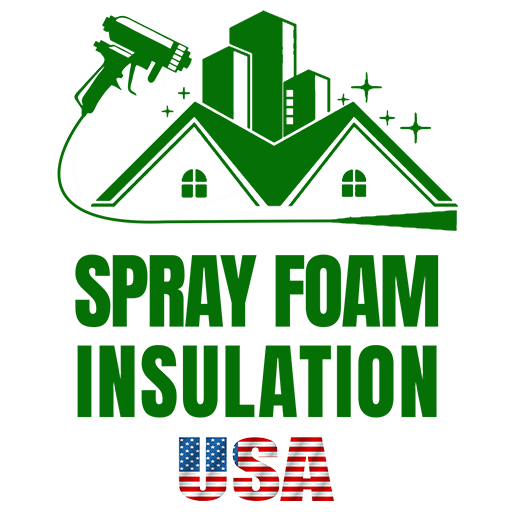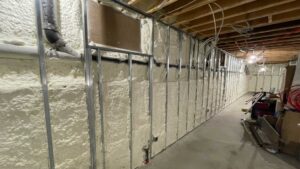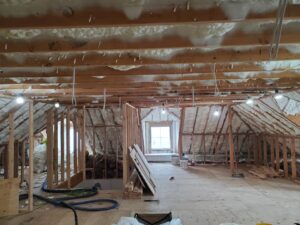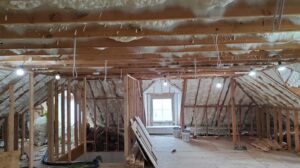Introduction
When you’re staring down the question, ‘how much is spray foam insulation per square foot?’, you’re likely seeking clear, straightforward answers. Let’s cut to the chase: Open-cell foam insulation tends to run from $0.44 to $0.65 per square foot, while Closed-cell foam insulation, providing greater moisture resistance and higher insulating power, averages about $1 to $1.50 per square foot.
Insulating your home or business isn’t just about keeping warm in the winter and cool in the summer. It’s a critical move toward slashing energy bills, enhancing indoor comfort, and contributing positively to the environment. Spray foam insulation stands out among insulation options for its superior ability to seal leaks and gaps in your home’s envelope. This isn’t just any upgrade; it’s an investment in a more sustainable, comfortable living environment for NY and NJ homeowners and business owners committed to quality, efficiency, and eco-friendliness.
Take a moment to digest the quick insight provided below through an infographic, designed to address your immediate query at a glance, simplifying your journey towards a smarter, insulated home or workspace.

Understanding the cost of spray foam insulation per square foot is just the starting point. The broader importance lies in the role insulation plays in your property – from energy efficiency to eco-friendliness, getting to grips with the basics sets the stage for a well-informed decision on enhancing your home or business’s insulation.
Understanding Spray Foam Insulation
When it comes to improving your home or business’s insulation, knowing your options is crucial. Spray foam insulation stands out for its effectiveness, but it’s not a one-size-fits-all solution. Let’s dive into the two main types of spray foam insulation: open-cell and closed-cell. Understanding these will help you answer the question: “how much is spray foam insulation per square foot?”
Open-Cell Foam Insulation
Open-cell foam is lighter and less dense than its counterpart. It’s like a sponge, with a structure that allows air to fill its tiny cells. This type makes it great for soundproofing, making your home quieter. It’s generally less expensive, costing $0.44–$0.65 per board foot. The R-value, which measures insulation’s ability to resist heat flow, is lower for open-cell foam, typically around 3.5 to 3.6 per inch. This means it’s not the best at keeping heat in or out, but it’s very effective at reducing noise.
Closed-Cell Foam Insulation
Closed-cell foam, on the other hand, is denser and more compact. Its cells are closed off, trapping gas inside, which provides a higher R-value of 6 to 7 per inch. This makes closed-cell foam a powerhouse at insulating and providing a moisture barrier. It’s more resistant to water and air leaks, making it ideal for areas prone to moisture like basements and bathrooms. The cost is higher, at $1–$1.50 per board foot, but it’s often worth it for the added protection and efficiency.
Choosing Between Open-Cell and Closed-Cell
The choice between open-cell and closed-cell foam insulation depends on several factors:
– Budget: Open-cell foam is more budget-friendly.
– Insulation Needs: If you’re looking for superior insulation and moisture resistance, closed-cell is the way to go.
– Application Area: For soundproofing interior walls, open-cell foam is excellent. For exterior walls or areas requiring moisture barriers, closed-cell foam offers better performance.
Understanding these differences is key to making an informed decision about your insulation needs. Whether you’re insulating a new construction or upgrading your existing home, knowing how much is spray foam insulation per square foot and the benefits of each type will guide you to the right choice for your project.
Factors Influencing Cost
When you’re exploring how much is spray foam insulation per square foot, you’ll quickly find that the answer isn’t as straightforward as you might hope. Several factors come into play, affecting the overall cost of your insulation project. Let’s break these down into easy-to-understand pieces.
Material
First up, the material. Spray foam insulation comes in two main types: open-cell and closed-cell. Open-cell foam is lighter and less expensive, costing between $0.44 and $0.65 per square foot. Closed-cell foam, on the other hand, is denser, offers a higher R-value, and acts as a moisture barrier, but it’ll set you back $1 to $1.50 per square foot. The choice between the two will significantly impact your project’s cost.
Thickness
Thickness is another crucial factor. The thicker the spray foam, the higher the R-value and the better the insulation’s performance. But, more material means higher costs. Deciding on the thickness involves balancing your insulation needs against your budget.
Location
Where you live can also affect the cost. Labor and material costs vary widely across different regions. For example, if you’re in a high-cost-of-living area, you can expect to pay more for both the materials and the labor to install them.
Labor Costs
Speaking of labor, the complexity of the job and the expertise of the installer play significant roles in determining the cost. Simple, easy-to-access projects will be on the lower end of the cost spectrum, while complex installations in hard-to-reach areas will be more expensive. Professional installation ensures quick, efficient work that adheres to building codes, but it does add to the overall cost.
Understanding these factors will help you navigate the costs associated with spray foam insulation. The goal is to achieve the best balance of cost and performance for your specific needs. As we move into the next section, keep these factors in mind, especially as we discuss the cost breakdown by type of spray foam insulation.
Cost Breakdown by Type
When it comes to spray foam insulation, understanding the costs involved is crucial for homeowners and builders alike. Let’s break it down by type to give you a clearer picture.
Open-Cell Foam Insulation
Open-cell foam insulation is the lighter option of the two, known for its ability to provide effective insulation and sound dampening. The cost ranges from $0.44–$0.65 per square foot. Its lower density means it has a lower R-Value, which measures insulation’s ability to resist heat flow. Despite this, it’s a popular choice for interior walls and attics, where moisture barrier properties are less of a concern.
- R-Value: Typically around R-3.5 per inch, making it suitable for indoor applications where a high R-Value per inch is not necessary.
- DIY options: Open-cell spray foam is more forgiving for DIYers, thanks to its expansion properties that make it easier to fill nooks and crannies without specialized equipment.
Closed-Cell Foam Insulation
On the other hand, closed-cell foam insulation is denser and offers a higher R-Value, around R-6 to R-7 per inch. This type of foam acts as a moisture barrier, making it ideal for locations prone to dampness, such as basements and crawl spaces. The cost for closed-cell foam insulation is higher, ranging from $1 to $1.50 per square foot. The additional cost brings several benefits, including:
- Moisture barrier: Its dense structure keeps water and moisture out, protecting your home from mold and mildew.
- Professional installation: Due to its density and the precision required for even application, professional installation is recommended. This ensures that the foam expands and cures properly, providing an effective air and moisture barrier.
Both types of spray foam insulation offer unique benefits. The choice between open-cell and closed-cell foam insulation depends on your specific needs, budget, and the area of your home you’re insulating.
- Open-cell foam is cost-effective and great for soundproofing and interior applications.
- Closed-cell foam, while more expensive, provides superior moisture protection and insulation in areas prone to dampness or where higher R-Values are required.
When considering how much is spray foam insulation per square foot, the initial investment can lead to significant energy savings over time. Additionally, selecting the right type of foam and considering professional installation can ensure that your insulation works effectively for years to come, making it a wise choice for both new construction and existing home renovations.
DIY vs. Professional Installation
When it comes to insulating your home with spray foam, you might be wondering if it’s better to tackle the job yourself or to hire professionals. Let’s break down both options, focusing on kits, protective gear, and VOCs for DIY projects, and expertise, building codes, and quick installation for professional services.
DIY Spray Foam Insulation
Kits: DIY spray foam insulation kits are available at most home improvement stores. These kits can range from $40 for a small project to $850 for larger areas. They usually come with everything you need to get started, including the foam, hoses, and spray gun. While these kits can be a cost-effective solution for small projects, they may not be suitable for insulating larger spaces.
Protective Gear: Safety is paramount when you’re applying spray foam insulation yourself. The chemicals involved can be harmful if inhaled or if they come into contact with your skin. It’s essential to wear the right protective gear, including a respirator mask, gloves, and goggles. A full-body suit is also recommended to protect your skin from exposure.
VOCs: Volatile Organic Compounds (VOCs) are chemicals that can off-gas from spray foam as it cures. These compounds can affect indoor air quality and may pose health risks. When applying spray foam, ensure your space is well-ventilated to minimize exposure to VOCs.
Professional Spray Foam Insulation
Expertise: Professional installers bring a wealth of knowledge and experience to the table. They are trained to handle the equipment safely and to apply the foam evenly and effectively. Professionals can also assess your space to determine the best type of foam for your needs, whether it’s open-cell or closed-cell.
Building Codes: Adhering to local building codes is crucial when installing spray foam insulation. Professionals are familiar with these regulations and can ensure that your insulation project complies with all local and national standards. This can save you from costly mistakes and potential fines.
Quick Installation: A professional team can complete an insulation project much faster than a DIY enthusiast. They have the tools, manpower, and expertise to get the job done efficiently. Moreover, many contractors offer warranties on their workmanship, giving you peace of mind that any issues will be addressed promptly.
In conclusion, while DIY spray foam insulation might seem like a cost-effective option for small projects, the complexities and potential risks involved make professional installation the safer and more reliable choice for most homeowners. With their expertise, adherence to building codes, and ability to quickly complete the job, professionals can ensure that your insulation is installed correctly, providing you with long-term energy savings and comfort.
Let’s delve into the additional costs to consider when planning your spray foam insulation project, ensuring you have all the information needed to make an informed decision.
Additional Costs to Consider
When you’re looking into how much is spray foam insulation per square foot, it’s easy to focus just on the insulation itself. But, there are a few more things you need to think about. These can change how much you spend in the end.
New Construction
For new buildings, the cost to install spray foam insulation tends to be a bit lower, ranging from $2.75 to $6.50 per square foot. This is because it’s easier to get into open spaces before the walls are finished. But remember, even in new construction, choosing the right type of spray foam (open-cell vs. closed-cell) matters and can affect the cost.
Existing Home
If you’re adding spray foam to an already built home, the cost goes up a bit, from $3.15 to $7.50 per square foot. Why? Because it’s harder to work around existing structures, electrical wiring, and plumbing. Plus, there might be extra work needed to prepare the space.
Mold Removal
If water has somehow gotten into your walls or attic, just pulling out old insulation won’t fix everything. You might need to deal with mold. Getting rid of mold and fixing any damage can cost $1,500 to $3,500. This step is super important for keeping your air safe to breathe.
Vapor Barrier
In places with a lot of moisture or rain, you might need more than just spray foam to keep water out. Adding a vapor barrier can help, and this will cost you an extra $0.65 to $1.00 per square foot. It’s an added layer of protection against dampness.
Understanding these extra costs helps you see the bigger picture. It’s not just about the spray foam; it’s about making sure your home is comfortable, safe, and dry. Keep these in mind as you plan your insulation project to avoid any surprises down the line.
Benefits of Spray Foam Insulation
When we talk about spray foam insulation, we’re diving into a world of benefits that stretch far beyond just keeping your home warm in the winter and cool in the summer. Let’s break down these advantages into bite-sized, easy-to-understand pieces.
Energy Efficiency
First up, energy efficiency. Spray foam insulation is like putting a super tight jacket around your home. It keeps the temperature inside just right, so your heating and cooling systems don’t have to work overtime. This means you could see your energy bills take a significant dive. Imagine having extra money each month because your home is just that efficient. That’s what spray foam can do.
Air Seal
Next, let’s chat about the air seal. Spray foam expands to fill up all those little cracks and gaps in your home. It’s like it’s playing hide and seek with air leaks and wins every time. This seal keeps the outside air out and the inside air in. Because of this, you won’t feel those pesky drafts anymore, and your home’s temperature stays consistent from room to room.
Moisture Barrier
Now, onto the moisture barrier. Water and moisture can be a home’s worst nightmare, leading to mold and mildew. But guess what? Spray foam insulation acts like an umbrella for your home. It repels water and doesn’t absorb moisture, which means those scary mold and mildew monsters won’t stand a chance.
Longevity
Lastly, we’ve got longevity. Spray foam insulation isn’t just a one-hit-wonder; it’s more like a classic hit that lasts for decades. We’re talking about a solution that can last up to 80 years. Yes, you heard that right. This means you install it and then just live your life, enjoying a comfortable home year after year without worrying about replacing it anytime soon.
In short, spray foam insulation is like the superhero of home comfort. It tackles energy bills, laughs in the face of drafts, shields you from moisture, and sticks around for the long haul. It’s a powerful ally in making your home the best it can be. Now, as we move forward, let’s explore how we can make the most of this superhero solution and even save some money in the process.
Reducing Spray Foam Insulation Costs
When it comes to insulation, spray foam stands out for its superior energy efficiency and durability. However, the question on everyone’s mind is: How can we reduce the costs associated with it? Let’s dive into some strategies that can help save money without compromising on quality.
Rebates
First off, rebates can be a game-changer. Many energy companies offer rebates for homes that improve their energy efficiency. By installing spray foam insulation, you might qualify for these rebates, effectively reducing the overall cost of the project. It’s like getting a pat on the back (and some cash back) for making your home more energy-efficient.
DIY Options
For those who are handy and willing to take on a project, DIY spray foam insulation might be the way to go. Open-cell spray foam, in particular, is more forgiving for DIY projects. You can purchase kits that come with everything you need to get started. However, proper safety gear is a must, and it’s crucial to follow instructions to the letter to avoid any mishaps. While DIY can save on labor costs, weigh this against the need for a professional finish, especially in tricky areas.
Open-Cell vs. Closed-Cell
Choosing between open-cell and closed-cell spray foam can also impact your costs. Open-cell foam is generally less expensive and can be a great option for interior walls and projects where moisture isn’t a big concern. On the other hand, closed-cell foam, while more costly, provides a higher R-value per inch and acts as a moisture barrier, making it ideal for areas prone to dampness.
By considering these factors – seeking out rebates, evaluating DIY options, and choosing the right type of foam – you can make spray foam insulation a more affordable choice for your home. The goal is to improve your home’s energy efficiency and comfort while keeping an eye on the budget. With a bit of research and planning, you can achieve just that.
As we move on to the next section, keep these cost-saving tips in mind. Whether you’re tackling a new construction project or upgrading your existing home, spray foam insulation offers long-term benefits that can outweigh the initial investment. Let’s continue to explore how spray foam insulation can be a smart choice for your home.
Frequently Asked Questions about Spray Foam Insulation
As we dive deeper into insulation, a few common questions often come up. Let’s tackle some of these head-on, providing clear, straightforward answers.
Is spray foam insulation worth it?
Absolutely. While the initial cost may seem high, the benefits of spray foam insulation make it a smart investment. It not only provides superior thermal insulation but also acts as an air seal, preventing drafts and air leaks. This can lead to significant savings on energy bills. Plus, it can last up to 80 years with minimal maintenance, making it a once-in-a-lifetime investment for most homeowners.
How much does it cost to insulate a 24×24 garage?
Calculating the cost to insulate a 24×24 garage involves a few variables, including the choice between open-cell and closed-cell spray foam. For a garage of this size, approximately 576 square feet, using closed-cell foam at an average cost of $1 to $1.50 per square foot, you could expect to spend between $576 to $864. This is a rough estimate. Factors such as wall height, local labor costs, and additional features like doors and windows can affect the final price.
Is it cheaper to spray foam insulation yourself?
Going the DIY route can seem tempting, especially with the availability of spray foam kits. However, it’s important to weigh the pros and cons. DIY kits might save on labor costs, but they require a careful application and understanding of the product. Mistakes can be costly and might not provide the airtight seal needed for optimal energy efficiency. Professional installation, while more expensive upfront, ensures the job is done right, adhering to building codes and maximizing the insulation’s effectiveness. For most people, the peace of mind and guaranteed quality of professional installation make it the better choice despite the higher initial cost.
It’s clear that spray foam insulation, whether done professionally or as a DIY project, offers significant benefits. Understanding the costs involved, the potential savings, and the long-term advantages can help homeowners make informed decisions about their insulation needs.
Conclusion
In wrapping up our exploration on spray foam insulation costs per square foot, revisit the core benefits and the value proposition offered by Spray Foam Insulation USA. Our commitment extends beyond just insulating homes; we aim to enhance your living experience by making it more energy-efficient, comfortable, and cost-effective in the long run.
Spray Foam Insulation USA stands at the forefront of delivering high-quality insulation services that are tailored to meet the unique needs of your home. Our expertise and dedication ensure that every project we undertake maximizes energy efficiency, contributing to significant long-term savings on energy bills.
Long-term Savings
Investing in spray foam insulation might seem like a hefty upfront cost, but it’s a decision that pays dividends in the long run. By creating an airtight seal, spray foam insulation drastically reduces the energy required to heat or cool your home. This reduction in energy consumption translates to lower utility bills, month after month, year after year. The insulation practically pays for itself over time through these savings.
Energy Efficiency
The superior energy efficiency of spray foam insulation is unmatched. Unlike traditional insulation materials, spray foam expands to fill every nook and cranny, creating an impenetrable barrier against air and moisture. This not only keeps your home warmer in the winter and cooler in the summer but also contributes to a healthier living environment by reducing the potential for mold and mildew growth.
Moreover, by choosing spray foam, you’re opting for a greener, more sustainable way to live. The energy savings achieved reduce the carbon footprint of your home, contributing to broader environmental conservation efforts.
Why Choose Us?
At Spray Foam Insulation USA, we understand that your home is your sanctuary. That’s why we’re dedicated to providing insulation solutions that enhance comfort, improve air quality, and promote energy efficiency. Our team of experts is equipped with the latest technology and knowledge to ensure that your insulation project is handled professionally from start to finish.
Choosing the right insulation is a critical decision for any homeowner. With Spray Foam Insulation USA, you’re not just insulating your home; you’re investing in a solution that will bring you comfort, savings, and peace of mind for years to come.
Ready to transform your home into a more energy-efficient space? Contact us today for a free estimate, and let us show you how spray foam insulation can make a difference in your life.






One Response
I prepping for a 16×30 metal building with 12 foot walls and 4/12 pitch roof. Garage door 9×8 will not be insulated. The door space will not have insulation.
What price do you ask to insulate this building?